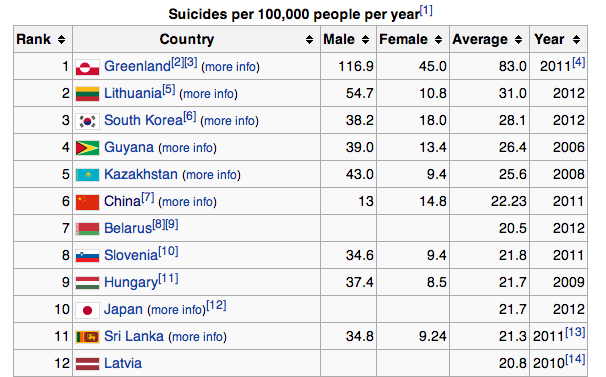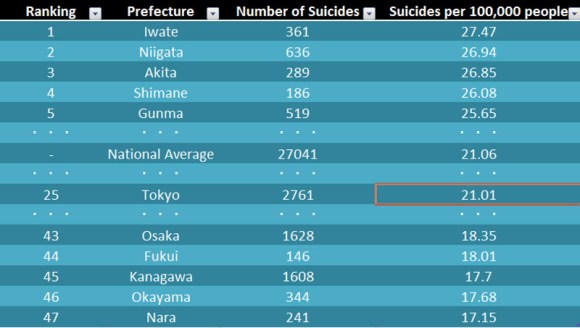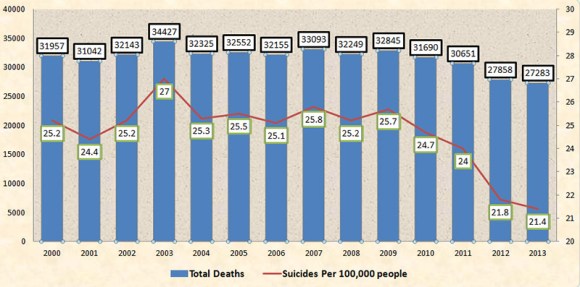
Live in urban Japan long enough and, as shocking as it sounds, you’re eventually going to have the distinctly unpleasant experience of riding a train that hits and more than likely kills a human being.
Even if you aren’t experiencing it firsthand, walking into a Tokyo train station only to notice yet another train delay caused by what is euphemistically described as a “bodily accident” (jinshin jiko, or 人身事故) is at least a weekly occurrence. It’s enough to make you think Japan must be wrestling with one hell of a suicide problem.
Which is true. But it’s not quite as bad as the Western media would have you believe. Here are five facts about suicide in Japan that are about as uplifting as we have any right to expect from facts about suicide:
1) Japan isn’t the suicide capital of the world.
While Japan has been the world leader in suicides in the past, that distinction currently belongs to Greenland, where an average of 83 out of 100,000 people took their own lives in 2011, according to the World Health Organization (WHO). Japan averaged 21.4 in 2013, the most recent year with available data.
2) Japan’s suicide capital isn’t Tokyo.
Despite the city’s frequent portrayal as a cold, unfeeling megalopolis filled with lonely, financially burdened salarymen who are all constantly just this shy of offing themselves, Tokyo isn’t actually Japan’s suicide capital. While it certainly has the highest number of suicides by virtue of its staggering population, Iwate Prefecture in the northeast recorded the highest rate at 27.5 suicides per 100,000 people in 2013.
3) “Train Jumpers” are surprisingly rare.
The overwhelming majority of suicides in Japan are by hanging, according to WHO. Going by some admittedly old data (2003), only 2.1% of male suicides and 3.6% of female suicides were death by train strike. Overdoses, hangings, and even jumping off of buildings and deliberate drowning were more common methods in that same year.
4) Rates are declining.
We just recently talked about how suicides in general in Japan are on the decline in recent years. While suicide is still far and away the leading cause of death among youths in Japan, that statistic actually isn’t as scary as it seems on the surface; with Japan’s low rate of violent crime and death by natural causes unsurprisingly low in that age group, the numbers speak more to Japan’s overall safety than to any kind of disturbing suicide trend.
5) The reasons are pretty much what you’d expect.
While there are certainly “shame culture” aspects to Japan’s high suicide rate, people are generally killing themselves for the reasons you’d probably expect any other place: Financial trouble and heartbreak. Divorce, debt and bankruptcy are some of the most common reasons for suicide in Japan.
So, there you have it. Rest assured that Japan’s relationship with suicide isn’t as unhealthy as you’ve probably heard. Still, all this talk of prematurely buying the farm has left me in dire need of some adorable cat pictures.
Source: Madame Riri
Feature Photo: Wikipedia – ajari




 Suicide rates for Japanese women/overall population reach historic low, with troubling exception
Suicide rates for Japanese women/overall population reach historic low, with troubling exception Suicides drop for second year in Japan, still leading cause of death among young adults
Suicides drop for second year in Japan, still leading cause of death among young adults Japan’s suicide number drops for eighth straight year, rises among teens
Japan’s suicide number drops for eighth straight year, rises among teens Suicide is the leading cause of death among young people in Japan, statistics show
Suicide is the leading cause of death among young people in Japan, statistics show 2014 suicide rates in Japan down, suicide in men still twice that of women
2014 suicide rates in Japan down, suicide in men still twice that of women Cup Noodle tries an authentic Jiro-style ramen, but something’s not quite right
Cup Noodle tries an authentic Jiro-style ramen, but something’s not quite right Hayao Miyazaki says Happy New Year to Studio Ghibli fans with new art for Year of the Horse
Hayao Miyazaki says Happy New Year to Studio Ghibli fans with new art for Year of the Horse What did Shibuya really look like after the crowds on New Year’s Day?
What did Shibuya really look like after the crowds on New Year’s Day? How to properly pronounce “Ghibli” and other fun trivia about the legendary animation studio
How to properly pronounce “Ghibli” and other fun trivia about the legendary animation studio Tokyo day-trip hot springs: Beautiful Mt. Fuji-view bath is just one highway bus stop from Shibuya
Tokyo day-trip hot springs: Beautiful Mt. Fuji-view bath is just one highway bus stop from Shibuya Pizza Hut Japan’s hot lucky bags are perfect for a New Year’s pizza party
Pizza Hut Japan’s hot lucky bags are perfect for a New Year’s pizza party Super long ebi fry proves Japanese portion sizes aren’t always small
Super long ebi fry proves Japanese portion sizes aren’t always small Hayao Miyazaki makes rare video appearance to check out Ghibli Museum’s revamped cafe【Video】
Hayao Miyazaki makes rare video appearance to check out Ghibli Museum’s revamped cafe【Video】 Japanese swimsuit models and cosplayers celebrate Bikini Day 2017【Photos】
Japanese swimsuit models and cosplayers celebrate Bikini Day 2017【Photos】 7-Eleven now sells rice burgers in Japan, blurring the line between fast and convenience store food
7-Eleven now sells rice burgers in Japan, blurring the line between fast and convenience store food Starbucks Japan ready to get Year of the Horse started with adorable drinkware and plushies【Pics】
Starbucks Japan ready to get Year of the Horse started with adorable drinkware and plushies【Pics】 7 great places to see Mt. Fuji from without having to climb it
7 great places to see Mt. Fuji from without having to climb it Cyberpunk anime meets traditional culture in Ghost in the Shell gold leaf Japanese changing screens
Cyberpunk anime meets traditional culture in Ghost in the Shell gold leaf Japanese changing screens Hello Kitty Choco Egg figures are an adorable trip through three periods of Japanese pop culture【Pics】
Hello Kitty Choco Egg figures are an adorable trip through three periods of Japanese pop culture【Pics】 We found possibly the quietest Japanese-style hotel in Tokyo’s bustling Shinjuku district
We found possibly the quietest Japanese-style hotel in Tokyo’s bustling Shinjuku district 7-Eleven Japan’s ramen-cooking robot whipped us up a bowl of noodles【Taste test】
7-Eleven Japan’s ramen-cooking robot whipped us up a bowl of noodles【Taste test】 Sumo Sanrio! Hello Kitty and pals team up with Japan Sumo Association for new merch【Pics】
Sumo Sanrio! Hello Kitty and pals team up with Japan Sumo Association for new merch【Pics】 Japan’s oldest largetooth sawfish in captivity back on display in Mie Prefecture
Japan’s oldest largetooth sawfish in captivity back on display in Mie Prefecture More Than a Capsule Stay: Why Solo Travelers Choose “global cabin Yokohama Chinatown”
More Than a Capsule Stay: Why Solo Travelers Choose “global cabin Yokohama Chinatown” 7-Eleven Japan starts new temporary luggage storage service in over 300 branches
7-Eleven Japan starts new temporary luggage storage service in over 300 branches Disillusionment at Tsukiji’s tourist-target prices led us to a great ramen restaurant in Tokyo
Disillusionment at Tsukiji’s tourist-target prices led us to a great ramen restaurant in Tokyo Starbucks teams up with 166-year-old Kyoto doll maker for Year of the Horse decorations【Photos】
Starbucks teams up with 166-year-old Kyoto doll maker for Year of the Horse decorations【Photos】 Tokyo considering law requiring more trash cans following litter increase in heavily touristed area
Tokyo considering law requiring more trash cans following litter increase in heavily touristed area Tokyo’s Tsukiji sushi neighborhood asks tour groups to stay away for the rest of the month
Tokyo’s Tsukiji sushi neighborhood asks tour groups to stay away for the rest of the month Tokyo event lets you travel back in time, for free, to celebrate 100 years since Showa era start
Tokyo event lets you travel back in time, for free, to celebrate 100 years since Showa era start Sanrio theme park in Japan announces plans to expand into a Sanrio resort
Sanrio theme park in Japan announces plans to expand into a Sanrio resort Japan may add Japanese language proficiency, lifestyle classes to permanent foreign resident requirements
Japan may add Japanese language proficiency, lifestyle classes to permanent foreign resident requirements Stamina-destroying “Paralysis Noodles” are Tokyo’s newest over-the-top ramen innovation
Stamina-destroying “Paralysis Noodles” are Tokyo’s newest over-the-top ramen innovation Survey asks foreign tourists what bothered them in Japan, more than half gave same answer
Survey asks foreign tourists what bothered them in Japan, more than half gave same answer Japan’s human washing machines will go on sale to general public, demos to be held in Tokyo
Japan’s human washing machines will go on sale to general public, demos to be held in Tokyo Japan’s deadliest food claims more victims, but why do people keep eating it for New Year’s?
Japan’s deadliest food claims more victims, but why do people keep eating it for New Year’s? We deeply regret going into this tunnel on our walk in the mountains of Japan
We deeply regret going into this tunnel on our walk in the mountains of Japan Studio Ghibli releases Kodama forest spirits from Princess Mononoke to light up your home
Studio Ghibli releases Kodama forest spirits from Princess Mononoke to light up your home Major Japanese hotel chain says reservations via overseas booking sites may not be valid
Major Japanese hotel chain says reservations via overseas booking sites may not be valid Put sesame oil in your coffee? Japanese maker says it’s the best way to start your day【Taste test】
Put sesame oil in your coffee? Japanese maker says it’s the best way to start your day【Taste test】 No more using real katana for tourism activities, Japan’s National Police Agency says
No more using real katana for tourism activities, Japan’s National Police Agency says Starbucks Japan reveals new sakura drinkware collection, inspired by evening cherry blossoms
Starbucks Japan reveals new sakura drinkware collection, inspired by evening cherry blossoms Updated cherry blossom forecast shows extra-long sakura season for Japan this year
Updated cherry blossom forecast shows extra-long sakura season for Japan this year Fewer people committed suicide in Japan last year than in any other year on record
Fewer people committed suicide in Japan last year than in any other year on record Reasons why it’s harder to raise kids in Japan than in other countries…or not
Reasons why it’s harder to raise kids in Japan than in other countries…or not 7 things Japanese people in international marriages wish they’d known before tying the knot
7 things Japanese people in international marriages wish they’d known before tying the knot Devoted David Bowie fan in Japan attempts to commit suicide following rock legend’s death
Devoted David Bowie fan in Japan attempts to commit suicide following rock legend’s death Famous suicide spot turned Pokémon GO hotspot reports zero deaths so far in 2017
Famous suicide spot turned Pokémon GO hotspot reports zero deaths so far in 2017 Rubbernecking gone too far? Net users react to crowds taking pics of train hit by suicide jumper
Rubbernecking gone too far? Net users react to crowds taking pics of train hit by suicide jumper Who has better manners? Blogger lists three things foreigners do that impress even the Japanese
Who has better manners? Blogger lists three things foreigners do that impress even the Japanese 5 ways Japanese TV shows are broken, according to expats
5 ways Japanese TV shows are broken, according to expats ‘Power harrassment’ in Japan’s police force blamed for officer’s suicide
‘Power harrassment’ in Japan’s police force blamed for officer’s suicide 5 common misconceptions most westerners have about Japanese food
5 common misconceptions most westerners have about Japanese food The coronavirus is making Japan’s suicide rate plummet
The coronavirus is making Japan’s suicide rate plummet Woman attempting suicide in Tokyo has life saved by 20 sumo wrestlers
Woman attempting suicide in Tokyo has life saved by 20 sumo wrestlers Parents of bullied teenage girl who committed suicide commission portrait to “attend” Seijinshiki
Parents of bullied teenage girl who committed suicide commission portrait to “attend” Seijinshiki 5 reasons foreigners find it hard to become friends with Japanese people
5 reasons foreigners find it hard to become friends with Japanese people Since when was Halloween so popular in Japan?
Since when was Halloween so popular in Japan? 6 things Japanese expats miss most about Japan
6 things Japanese expats miss most about Japan
Leave a Reply